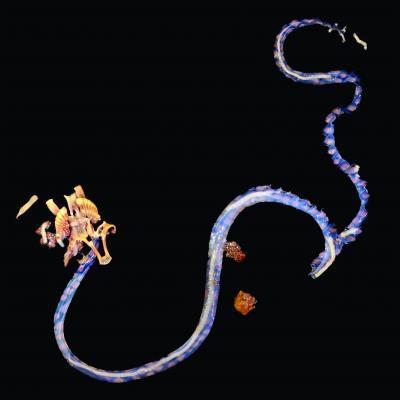Have you ever heard of a creature with a skeleton so extraordinary that it challenges the conventional understanding of vertebrates? Enter the hagfish, a fascinating and ancient sea-dwelling creature that defies expectations with its spine-tingling skeletal system.
The Peculiarities of Hagfish Anatomy
No Bones About It: One of the most remarkable aspects of hagfish anatomy is the absence of true bones. Unlike most vertebrates, hagfish do not possess a rigid internal skeleton made of bone tissue. Instead, they rely on a cartilaginous structure to maintain their form. This flexibility is a key adaptation for their unique lifestyle, allowing them to navigate the tight spaces within the ocean’s nooks and crannies.
Cartilage Chronicles: Hagfish skeletons consist primarily of cartilage, the same tissue that forms the flexible framework in the noses and ears of humans. This cartilaginous structure provides hagfish with a distinct advantage: the ability to compress their bodies and squeeze into tight spaces, making them well-adapted for scavenging on the ocean floor.
Slippery When Squeezed: Another intriguing feature of hagfish anatomy is their slime-producing glands. When threatened, hagfish can exude copious amounts of slime, creating a slippery and protective barrier that helps them escape predators. This unique defense mechanism is not directly related to their skeletal structure, but it showcases the overall adaptability and survival strategies these creatures have developed.
The Evolutionary Enigma of Hagfish
Living Fossils: Hagfish are often referred to as “living fossils” due to their ancient lineage. These creatures have been around for over 300 million years, predating even the dinosaurs. The evolutionary journey of hagfish is a puzzle that scientists continue to unravel, with their unconventional skeletons playing a central role in understanding the broader context of vertebrate evolution.
Missing Links: Studying hagfish provides valuable insights into the evolutionary transition from jawless to jawed vertebrates. Their lack of true bones challenges the traditional narrative of skeletal evolution, raising questions about the missing links in our understanding of the development of vertebrate skeletons. Unraveling these mysteries may reshape our understanding of the evolutionary milestones that paved the way for the diverse vertebrate forms we see today.
Survivors Through Time: Despite their primitive appearance, hagfish have proven to be highly successful survivors throughout evolutionary history. Their adaptability, coupled with a unique set of features like a cartilaginous skeleton and slime-producing glands, has allowed them to persist through the ages, adapting to changing environments and outlasting many other ancient species.
Hagfish in the Modern World
Ecosystem Engineers: Today, hagfish continue to play a vital role in marine ecosystems as scavengers and decomposers. Their feeding habits help maintain the balance of oceanic ecosystems by recycling nutrients from decaying organic matter on the ocean floor. The flexibility of their skeletons allows them to access and consume a wide variety of prey, contributing to the overall health of the underwater world.
Scientific Curiosity: Beyond their ecological significance, hagfish captivate the scientific community. Researchers are delving into the mysteries of hagfish anatomy, genetics, and behavior to unlock the secrets of their evolutionary success. By studying these enigmatic creatures, scientists hope to gain deeper insights into the fundamental processes that have shaped the diversity of life on Earth.
Conservation Concerns: Despite their resilience, hagfish face threats from human activities, such as overfishing and habitat destruction. Understanding the ecological roles of hagfish and recognizing their importance in marine ecosystems is crucial for their conservation. Preserving the habitats that support these unique creatures is essential for maintaining the delicate balance of the oceanic environment.
Frequently Asked Questions (FAQs)
Q1: Do hagfish have any predators, considering their slime defense mechanism?
A1: While the slime produced by hagfish can deter some predators, they are not completely invulnerable. Sharks, larger fish, and some deep-sea scavengers have evolved strategies to feed on hagfish, navigating through the slime to make a meal of these unique creatures.
Q2: Can hagfish be kept in captivity?
A2: Keeping hagfish in captivity is challenging due to their specific environmental requirements and feeding habits. Their sensitivity to changes in water quality and the difficulty in replicating their natural habitat make it a complex task. As of now, successful long-term captivity efforts are limited.
Q3: How do hagfish contribute to marine ecosystems?
A3: Hagfish play a crucial role in marine ecosystems as scavengers and decomposers. By consuming decaying organic matter on the ocean floor, they help recycle nutrients and maintain the balance of underwater environments. Their feeding habits contribute to the overall health of marine ecosystems.
Is this conversation helpful so f

